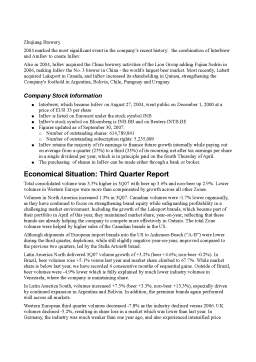Extras din referat
Company Description
InBev is the world's leading brewer, realizing 13.3 billion euro in 2006. The company has a strong,
balanced portfolio, holding the number one or number two position in over 20 key markets – more than
any other brewer. It has a key presence in both developed and developing markets, active in 7 out of the
10 of the fastest growing markets worldwide.
Headquartered in Leuven, Belgium, InBev employs almost 88,000 people worldwide. With sales in
over 130 countries, the company works through six operational zones: North America, Western Europe,
Central and Eastern Europe, Asia Pacific, Latin America North, and Latin America South. With
operations and license agreements around the globe, InBev is a true global brewer.
InBev has four global brands, Stella Artois®, Beck’s®, Leffe® and Brahma®, and as a top-tier
performer in the global brewing industry, InBev has the potential to generate one of the highest organic
EBITDA growths of any major brewer.
In addition, InBev has a portfolio of more than 200 local brands including:
In Latin America: Skol®, the third largest beer brand in the world.
In Western Europe: Jupiler®, the number 1 selling beer in Belgium.
In Central and Eastern Europe: Siberian Crown,® a leading premium brand sold throughout
Russia.
In Asia Pacific: Cass® from South Korea, and Sedrin®, a 10 million hectoliter brand in China.
Company History
InBev’s roots can be traced back to Den Horen in Leuven, which began making beer in 1366.
In 1987 the two largest breweries in Belgium merged: Artois, located in Leuven, and Piedboeuf,
located in Jupille signaling the formation of the single company which was to become Interbrew.
After the merger in 1987, Interbrew acquired a number of local breweries in Belgium.
By 1991, a second phase of targeted external growth began outside of Belgium’s borders. The first
transaction in this phase took place in Hungary, followed in 1995 by the acquisition of Labatt, in
Canada, and then in 1999 by a joint venture with Sun in Russia.
In 2000, InBev acquired Bass and Whitbread in the U.K., and in 2001 the company established itself in
Germany, with the acquisition of Diebels. This was followed by the acquisition of Beck’s & Co.,the
Gilde Group and Spaten.
Interbrew operated as a family-owned business until December 2000. At this point it organized an
Initial Public Offering, becoming a publicly owned company trading on the Euronext stock exchange
(Brussels, Belgium).
In 2002, Interbrew strengthened its position in China, by acquiring stakes in the K.K. Brewery and the
Zhujiang Brewery.
2004 marked the most significant event in the company’s recent history: the combination of Interbrew
and AmBev to create InBev.
Also in 2004, InBev acquired the China brewery activities of the Lion Group adding Fujian Sedrin in
2006, making InBev the No. 3 brewer in China - the world's largest beer market. Most recently, Labatt
acquired Lakeport in Canada, and InBev increased its shareholding in Quinsa, strengthening the
Company's foothold in Argentina, Bolivia, Chile, Paraguay and Uruguay.
Company Stock Information
- Interbrew, which became InBev on August 27, 2004, went public on December 1, 2000 at a
price of EUR 33 per share
- InBev is listed on Euronext under the stock symbol INB
- InBev's stock symbol on Bloomberg is INB.BB and on Reuters INTB.BE
- Figures updated as of September 30, 2007:
- Number of outstanding shares: 614,789,841
- Number of outstanding subscription rights: 5,235,089
- InBev retains the majority of it's earnings to finance future growth internally while paying out
on average from a quarter (25%) to a third (33%) of its recurring net after tax earnings per share
in a single dividend per year, which is in principle paid on the fourth Thursday of April.
- The purchasing of shares in InBev can be made either through a bank or broker.
Economical Situation: Third Quarter Report
Total consolidated volume was 3.5% higher in 3Q07 with beer up 3.6% and non-beer up 2.9%. Lower
volumes in Western Europe were more than compensated by growth across all other Zones.
Volumes in North America increased 1.3% in 3Q07. Canadian volumes were -1.7% lower organically,
as they have continued to focus on strengthening brand equity while safeguarding profitability in a
challenging market environment. Including the growth of the Lakeport brands, which became part of
their portfolio in April of this year, they maintained market share, year-on-year, reflecting that these
brands are already helping the company to compete more effectively in Ontario. The total Zone
Preview document
Conținut arhivă zip
- Investment Markets - InBev NV.pdf










